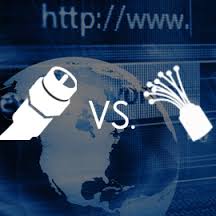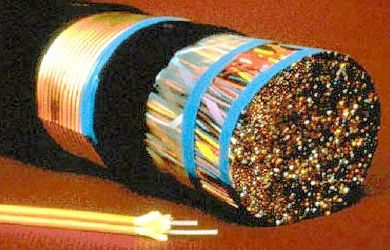|
Which is better Fiber or Cable?
Fiber Optic Internet is coming to a neighborhood near you. It may even be in your neighborhood already. Should you drop your cable, or DSL, (if you are so afflicted) and go with the fiber? There are some advantages to the fiber system.
 Fiber Optic or Copper Cable Fiber Optic or Copper Cable
Fiber has greater bandwidth. Without going into a technical discussion of bandwidth suffice it to say that means more data bits per second. If we have two vehicles traveling down the highway at about the same speed but one is a tractor/trailer hauling triples and the other is a Smart Car which one can haul the greatest amount of stuff?
Fiber is faster. While the theoretical “top end” speed of fiber is faster than the theoretical “top end” speed of cable in most cases neither technology is maxed out at this time. Remember that bringing fiber up to your building is great but if you have copper wire running those last hundred feet to your computer then you will only get the speed of the slowest component in your network. See NOTE
Fiber is more secure. Unscrupulous types can “tap” a wired line with electrical current flowing through it. There is a magnetic field generated by the electricity flowing through the wire and that magnetic field can be “read”. That type tap can be very hard to detect. It is almost impossible to tap a fiber optic cable with pulses of light flowing through a glass fiber because there is no magnetic field. This also makes fiber much less susceptible to electro-magnetic interference from outside sources.
How much does it cost? Well that is something of a moving target. Initially fiber was more expensive, a lot more. Unlike cable which uses the TV cable already in place in most areas fiber requires a whole new infrastructure to be built and installed. That costs a lot of money. As more and more fiber trunk lines become available the cost per household has come down.
In some areas local governments are getting into the act. Cities are laying their own fiber lines in the ground and signing up residents for fiber optic service. This is a really dumb idea on the part of the local municipalities but if it means cheap fiber service for you DO IT!
What is going to happen?
 The fiber cable in the foreground can transmit as much data as the coper cable in the background. The fiber cable in the foreground can transmit as much data as the coper cable in the background.
Eventually they will learn that while they may have some skills at running a city they know nothing about running a technology services company. Typically governments wildly over estimate revenues and equipment life cycles while grossly underestimating costs and liabilities. Also these estimates are based on the metrics currently in place.
The metrics change. Companies like Verizon and Comcast will counter with a combination of higher speeds, lower costs and more features. These “mega-corps” can afford to lose money like this for decades while most cities cannot afford to lose money like that for even one year. The cities will get squeezed and the corporate giants will eventually come in to “save” them. In other words buy them out.
But in the mean time you have fiber service and possession being nine tenths of the law, you have the advantage. The infrastructure is in place and customers have been signed up. The big company takes over, now that all the hard work has been done. The price of the service will go up just like the price of everything else.
Fiber optic will be the standard going forward. The sooner you get in the sooner you will be enjoying the improved service. And the big tech companies will make lots of money from it. But you already knew that, right!
NOTE:
Most wired devices built in the last few years are capable of gigabit, (1000 Megabit) speeds. Prior to that the top speed was 100 Mb. Wireless “N” class, and earlier devices are limited to about 54 Mb by FCC rules. Higher speeds are attained by using multiple channels, (if available) simultaneously. The “AC” wireless devices can run up to about 800Mb. The “real world” speed of wireless devices is usually no more than about 75% of the advertised speeds.
And remember always back it up!
Go back to the top
|